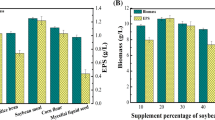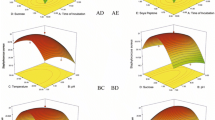Abstract
Optimization of submerged culture conditions for the production of mycelial growth and exopolysaccharides (EPSs) by Collybia maculata was investigated. The optimum temperature and the initial pH for EPS production in a shake-flask culture of C. maculata were found to be 20°C and 5.5, respectively. Among the various medium’s constituents examined, glucose, Martone A-1, K2HPO4, and CaCl2 were the most suitable carbon, nitrogen, and mineral sources for EPS production, respectively. The optimum concentration of the medium’s ingredients determined using the orthogonal matrix method was as follows: 30 g/L of glucose, 20 g/L of Martone A-1, 1g/L of K2HPO4, and 1g/L of CaCl2. Under the optimized culture conditions, the maximum concentration of EPSs in a 5-L stirred-tank reactor was 2.4 g/L, which was approximately five times higher than that in the basal medium. A comparative fermentation result showed that the EPS productivity in an airlift reactor was higher than that in the stirred-tank reactor despite the lower mycelial growth rate. The specific productivities and the yield coefficients in the airlift reactor were higher than those in the stirred-tank reactor even though the volumetric productivities were higher in the stirred-tank reactor than in the airlift reactor.
Similar content being viewed by others
References
Berovic, M., Habijanic, J., Zore, I., Wraber, B., Hodzar, D., Boh, B., and Pohleven, F. (2003), J. Biotechnol. 103, 77–86.
Bok, J. W., Lermer, L., Chilton, J., Kilingeman, H. G., and Neil Towers, G. H. (1999), Phytochemistry 51, 891–898.
Nam, K. S., Jo, Y. S., Kim, Y. H., Hyun, J. W., and Kim, H. W., (2001), Life Sci. 35, 229–237.
Cheung, L. M., Cheung, P. K., and Ooi, V. C. (2003), Food Chem. 81, 249–255.
Han, M. D., Lee, J. W., Jeong, H., Chung, S. K., Lee, S. Y., and Yoon, K. H. (1995), Kor. J. Mycol. 23, 209–225.
Shiao, M. S., Lee, K. R., Lin, L. J., and Wang, C. T. (1994), in Food Phytochemicals for Cancer Prevention II, American Chemical Society, Washington, DC, pp. 342–354.
White, R. W., Hackman, R. M., Soares, S. E., Beckett, L. A., and Sun, B. (2002), Urology 60, 640–644.
Azam, M., Kesarwani, M., Natarajan, K., and Datta, A. (2001), Biochem. Biophys. Res. Commun. 289, 807–812.
Kuehnelt, D., Goessler, W., and Lrgolic, K. J. (1997), Appl. Organomet. Chem. 11, 289–296.
Kim, S. W., Hwang, H. J., Xu, C. P., Choi, J. W., and Yun, J. W. (2003), Lett. Appl. Microbiol. 36, 321–326.
Biazar, J., Tango, M., Babolian, E., and Islam, R. (2003), Appl. Math. Comput. 144, 433–439.
Park, J. P., Kim, S. W., Hwang, H. J., and Yun, J. W. (2001), Lett. Appl. Microbiol. 33, 76–81.
Yang, F. C., and Liau, C. B. (1998), Bioprocess Eng. 19, 233–236.
Kim, S. W., Hwang, H. J., Xu, C. P., Na, Y. S., Song, S. K., and Yun, J. W. (2002), Lett. Appl. Microbiol. 34, 389–393.
Cho, D. H., Chae, H. J., and Kim, E. Y. (2001), Appl. Biochem. Biotechnol. 95, 183–193.
Bae, J. E., Sinha, J., Park, J. P., Song, C. H., and Yun, J. W. (2000), J. Microbiol. Biotechnol. 10, 482–487.
Griffin, D. H. (1994), Fungal Physiology, 2nd ed., Wiley-Liss, New York.
Jonathan, S. G. and Fasidi, I. O. (2001), Food Chem. 72, 479–483.
Chardonnet, C. O., Sams, C. E., and Conway, W. S. (1999), Phytochemistry 25, 967–973.
MacAtrain, P., Jacquier, J. C., and Dawson, K. A. (2003), Carbohydr. Polym. 53, 395–400.
Xu, C. P., Kim, S. W., Hwang, H. J., Choi, J. W., and Yun, J. W. (2003), Process Biochem. 38, 1025–1030.
He, Y. and Lee, H. K. (1998), J. Chromatogr. 793, 331–340.
Huang, C. T., Su, Y. Y., and Hsieh, Y. Z. (2002), J. Chromatogr. 977, 9–16.
Prihardi, K., Kengo, K., Toshiharu, I., Jun, H., Mami, K., and Mitsuyasu, O. (2002), J. Biosci. Bioeng. 93, 274–280.
Emilio, M. G., Yusuf, C., and Murray, M. Y. (1997), J. Biotechnol. 54, 195–210.
Author information
Authors and Affiliations
Rights and permissions
About this article
Cite this article
Lim, J.M., Kim, S.W., Hwang, H.J. et al. Optimization of medium by orthogonal matrix method for submerged mycelial culture and exopolysaccharide production in Collybia maculata . Appl Biochem Biotechnol 119, 159–170 (2004). https://doi.org/10.1385/ABAB:119:2:159
Received:
Revised:
Accepted:
Issue Date:
DOI: https://doi.org/10.1385/ABAB:119:2:159




